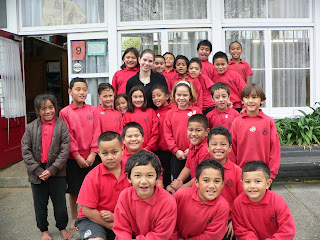By: Tyler Mills
The driving question for this blog post is,
"What assistive technologies are available to you as a teacher?" The video that I found interesting in the blog instructions was
ipad usage for the blind. It showed a man named Wesley Majerus who was blind fully operate a stock ipad. He was giving lessons and tips of how to use the ipad as a vision impaired student. Wesley demonstrated how to operate using Voice Over. The system works by simply dragging your finger over items that appear on the screen. The Voice Over systems reads out whatever your finger comes across and makes a ticking noise when your finger is over a blank area. This is extremely helpful for a vision impaired student and helps them keep up with the rest of the class.
Through my own research I came across an ability to dictate what you want your apple product to type. The process is called dictation which is available on apple products. While viewing the video
Dictation on Mac, iPhone, and iPad, by Steve Dotto I got an idea of how dictation works. Dictation works by saying anything aloud and your device typing the words out for you. This may help out a student that is born with no arms or hands to type. The system can be used to type papers in microsoft word and other systems. Mentioned in the video by Mr. Dotto, the dictation can not be used in google drive. I still believe this can be a big help to a handicap person.

By: Amber Harris:
What assistive technologies are available to you as a teacher?
After watching,
"Assistive Technologies for Vision and Hearing Impaired Children", the video clearly shows educators that if they utilize the technologies available they can actually change a learning experience for a child with either a visual or hearing impairment. I agree that more awareness should be given to professionals to incorporate these types of technologies for children who not only suffer from sensory impairments,but for some teachers there is a resistance to incorporating new media in their daily teaching for the benefit of all students. More teachers need to be equipped with the skills to use these technologies. As with all professional learning surrounding the use of technology, teachers cannot expect to be handed a 'how to' manual on how to use and implement these technologies.
With some research on my own, I asl found the webpage
"Computer Based Assistive Technology." This webiste gives 10 assistive technologies, such as Speech Synthsis Software. "Speech synthesizers are basically screen readers. They read text that is displayed on the computer monitor, allowing students to gain independent access to assignments, books, and research. Teachers or students do, however, need to pre-scan material before they can use it. Speech synthesis allows them to access the print in textbooks, and thereby the curriculum, in a way that would otherwise be more difficult, if not impossible. It may even increase student motivation to read." (Montali & Lewandowski, 1996)
How students can use speech synthesis software:
1. Where text is available in digital form (i.e., on the computer or diskette), students can have text read to them.
2. Some screen readers can read in a variety of applications, including the Internet.
3. Some Internet sites have collections of textbooks available to be read by screen readers.
4. Students can control the pace of the reading and the reading selection, through having the computer read only the words they are having difficulty decoding or a whole paragraph or passage.
5. Students can manipulate the rate of read-back to allow for variations in the speed they process auditory information.
by: Mallory Harris
The driving question for this post was,
"What assistive technologies are available to you as a teacher?"
For this assignment, I Googled assistive technology in the classroom. There were some pretty interesting results. The first resource that I cam across was
Bookshare. It is a website with a free online library for people with print disabilities. The website help people who have trouble reading.
This website seemed like it could be very useful for me in the future because I am going to be an english teacher and some of my students may be able to get some use out of the site.
The next resource that I found was
Quality Indicators for Assistive Technology. This is a website that offers information in its resources section as well as access to the QIAT list serv. The list serv is an excellent forum to keep current with new developments in AT and the latest websites and other resources.
This would be an imprtant website when working with assistive technology because it could keep me up to date with the standards.
I also watched the video assigned by Dr.Strange called
Assistive Technologies for Vision and Hearing Impaired Children. The video was about the different types of assistive technologies that can be found in the classroom and listed some of the reasons why it is important to know about these technologies.
Sheridan’s Blog #12 Work
For this weeks blog assignment, the driving question is, "What assistive technologies are available to you as a teacher?". To be honest, I have not thought about what technological tools that could be out there to help with special needs students. When I received this topic, I was actually able to put myself in a current teachers shoes and began to think "what if" I have a student that is blind or deaf. The videos that were assigned for us to watch were very useful and relating to what questions I had about this topic.
The first video,
The Mountbatten created by The Florida School for the Deaf and Blind, was relating to a device that uses audio/feedback. It can save files, transfer files to a computer, and receive files from a computer. This device is great for a student and/or teacher who does not know brail. Blind students are now not limited to what they can do not but rather be included in projects and be held to a responsibility of doing their part of the work.

The second video,
Teaching Math to the Blind by Professor Art Karshmer University of San Francisco, informs us how they have created a touch-pad that blind students will be able to use to learn mathematics. Students will be able to use special (braille engraved) blocks and align math problems in a 2-dimensional way so they may learn as normal students learn. The touch-pad will keep track of the coordinates of each block students can keep up with where they have laid previous blocks. It is a foundation for blind students so that they may learn the basics of mathematics. The picture below is a touch-screen display of graphical mathematics for blind students.

This last video,
iPad usage for the blind, I found the most amazing and intriguing. Apple has developed a voice-over for the iPad that enables the blind to use the iPad just as a normal person with normal vision can. Wesley (who is blind) demonstrates this in the video by using the voice-over on the iPad and telling/showing us what all he can do with it. It is amazing technology that expands the blinds capability so far. I love how Apple has created such an amazing tool that not only helps for learning purposes, but also, to help create the feeling of normality to blind students/people.










